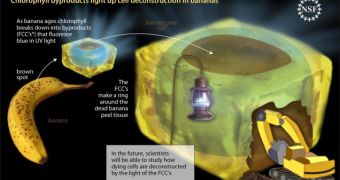An international group of researchers has recently discovered the fact that banana peels, which may be a clear indicator that the fruits have gone bad on the inside, do not change their aspect as they deteriorate. At least not in visible wavelengths. When researchers placed the peels under ultraviolet (UV) light, they discovered that, if spoiled, they gave off a blue glow. The team determined that this was caused by chlorophyll aging and beginning to disintegrate, the US National Science Foundation (NSF) informs.
In charge of the new investigation were experts Nicholas Turro, from the Columbia University, and Bernhard Krautler, from the University of Innsbruck. In their new paper, which appears in the latest issue of the respected journal Proceedings of the National Academies of Sciences (PNAS), they show that chemists and molecular biologists could have a field day with the new-found knowledge. If molecules become “trackable” in UV light when they are around dying tissue, then the research holds promise for further investigating the process known as programmed cellular death (PCD).
“This work brings to fruition some of the remarkable principles of fundamental organic photochemistry harvested from more than four decades of Professor Turro's research at Columbia,” NSF Chemistry Division Program Officer George Kenyon explains. In the journal paper, the authors again highlight the importance of chlorophyll for life on Earth. The substance has the ability to allow plants to absorb sunlight and turn it into energy, while changing carbon dioxide into oxygen at the same time.
When chlorophyll compounds reach the end of their life span, they go out in impressive displays of colors, which is precisely what the team discovered while looking at banana peels in UV wavelengths. Each of the brown spots on the fruits, which announce their transition from ripe to rotten, shines with its own halo of UV light, the experts announce. This is one of the first studies to evidence that not all chlorophyll breaks down in red and yellow colors, as it does in tree foliages in autumn.

 14 DAY TRIAL //
14 DAY TRIAL //